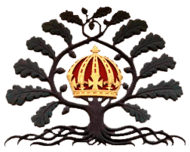English Mistery
The English Mistery ("Mistery" being an old word for a guild) was a political and esoteric group active in the United Kingdom of the 1930s. A "Conservative fringe group" in favour of bringing back the feudal system,[1] its views have been characterised as "reactionary ultra-royalist, anti-democratic".[2] It was against everything to do with welfare, the London School of Economics, and the United States.[3]
 | |
| Formation | 1930 |
|---|---|
| Type |
|
| Purpose | Socio-political organisation and publishing society |
| Location | |
Key people |
|
| Part of the Politics series on |
| Toryism |
|---|
 |
|
Characteristics
|
Founder
It was founded by William Sanderson and took its title from his 1930 book That Which Was Lost: A Treatise on Freemasonry and the English Mistery. Sanderson was a Freemason but disaffected, a member of the Imperial Fascist League and author of a previous book Statecraft (1927),[4] and founded the group in 1930 to promote his view of 'leadership'.[5]
Historical context
Stone has stated that the importance of the English Mistery lay “in the fact that it had links, both personal and ideological, with much wider strands of thought in interwar Britain.”[6] As with the British Union of Fascists, many of its members were “aristocratic revivalists and Diehard peers of the Edwardian period”.[7] Their ideas, now regarded as extreme, spoke to acute and home-grown issues: Britain, one of the biggest imperial powers, was seeing rapid social and constitutional changes. English fascism had its roots in "diehards", who “made of illiberalism, extreme nationalism, militarism, and racism a base from which home-grown fascist ideas could develop in Britain”.
Ideology
The English Mistery was founded by William Sanderson in 1930 as a forum for discussion of issues and problems: politics, economics, religion, eugenics, women, Jews, etc. The movement was elitist, and attracted landowners, political figures (e.g. Sir Reginald Dorman-Smith MP, Minister of Agriculture, 1939-1940), some members of the aristocracy, and intellectuals. Mistery meant the mastery of service: to serve and to be subordinate. The Mistery dreamt of an England with a hierarchy and a nation of racially pure Englishmen who were led by a monarch and supported by strong leaders.
They wanted to return leadership to the English aristocracy; a small elite would rule over the English race. Submissive races could be the victim of brutalities and slaughter, but this was a good thing: “Surely, therefore, the time has come to recognise the inevitability of violence and sacrifice, and consciously to select the section or elements in the world or the nation that should be sacrificed”.[8] This way of thinking was not unique, as Stone explains: “The slaughter of primitive peoples as a way of venting the Englishman's excess energy, has been long a mainstay of British imperial thinking.”[9]
Membership
Its members included the British Nietzschean Anthony Ludovici,[10] who was one of the most prolific writers of the movement and helped form its ideology, and the journalist Collin Brooks.[11] Others were Rolf Gardiner and Graham Seton Hutchison,[12] founder in 1933 of the pro-Nazi and anti-Semitic National Workers' Movement,[13] and the diplomat Cecil de Sausmarez.[14] Conservative MPs Gerard Wallop, Michael Beaumont and Reginald Dorman-Smith joined. Beaumont left: both he and Dorman-Smith found the Mistery inactive in practical terms.[15][16] The barrister John Platts-Mills belonged to the group and his flat at 2, Paper Buildings, Inner Temple, was the Mistery's address and meeting place for a time.[17]
Wallop eventually split the group in 1936, forming his successor organisation, the English Array. This schism left the Mistery in poor shape.
References
- E. H. H. Green, Ideologies of Conservatism: Conservative Political Ideas in the Twentieth Century (2002), p. 151.
- Thomas Linehan, British Fascism, 1918-1939: Parties, Ideology and Culture (2000), p. 141.
- Patrick Wright, The Village that Died for England (2002 edition), p. 204.
- Thomas Linehan, British Fascism 1918–39: Parties, Ideology and Culture (2000), p. 73.
- Dan Stone, Breeding Superman: Nietzsche, Race and Eugenics in Edwardian and Interwar Britain (2002), p. 42.
- Stone, D. (2003). "The English Mistery, the BUF, and the Dilemmas of British fascism". The Journal of Modern History. 75: 337. doi:10.1086/380138.
- Stone, D. (2003). "The English Mistery, the BUF, and the Dilemmas of British fascism". The Journal of Modern History. 75: 340. doi:10.1086/380138.
- Ludovici, Anthony (1933). Violence, Sacrifice and War. London: The St. James' Kin of the English Mistery. pp. 11–12.
- Stone, D. (1999). "The extremes of Englishness: The 'exceptional' ideology of Anthony Mario Ludovici". Journal of Political Ideologies. 4 (2): 202. doi:10.1080/13569319908420795.
- Stone, p. 45.
- Stephen Dorril, Blackshirt (2006), p. 296.
- Richard Griffiths, Patriotism Perverted (1998), p. 52.
- Peter Barberis, John McHugh, Mike Tyldesley, Encyclopedia of British and Irish Political Organizations: Parties, Groups (2003),p. 193.
- Wright, p. 204.
- Stone, p. 43.
- Peter Barberis, John McHugh, Mike Tyldesley, Encyclopedia of British and Irish Political Organizations: Parties, Groups (2003), p. 182.
- Stephen Sedley (11 November 1999). "In Judges' Lodgings". London Review of Books. 21 (22). Archived from the original on 2008-08-08.
Sources
- Stone, D. (2003). "The English Mistery, the BUF, and the Dilemmas of British fascism". The Journal of Modern History. 75: 336–358. doi:10.1086/380138.